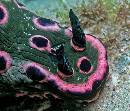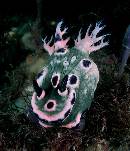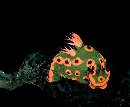 "A
nudibranch with hot pink and orange fluorescent donut rings, I'd like to see
that! It's not every day that you come across one the rarest nudibranchs in
the Pacific region"
"A
nudibranch with hot pink and orange fluorescent donut rings, I'd like to see
that! It's not every day that you come across one the rarest nudibranchs in
the Pacific region"Family: Polyceridae
 "A
nudibranch with hot pink and orange fluorescent donut rings, I'd like to see
that! It's not every day that you come across one the rarest nudibranchs in
the Pacific region"
"A
nudibranch with hot pink and orange fluorescent donut rings, I'd like to see
that! It's not every day that you come across one the rarest nudibranchs in
the Pacific region"
The Donut Nembrotha (Nembrotha sp) is a very unique nudibranch species that has only been recorded from a couple of locations in Australia. Even though it is large brightly coloured nudibranch species it is rarely seen by scuba divers.
 There
is one known location in the world where this species can be regularly encountered.
The location is Cabbage Tree Island off Port Stephens in New South Wales - Australia
where it is known to occur on the sheltered western side of the island in depths
of 7 to 16 metres. On the western side of the island grows a purple ascidian
(Sigillina cyanea) which is the only food source that the Donut Nembrotha is
known to feed on. If divers closely examine the purple ascidians they may be
fortunate enough to find a Donut Nembrotha feeding or laying its eggs. This
species has also been seen with the tropical Imperial Shrimp (Periclimenes imperator)
hitching a ride on its back.
There
is one known location in the world where this species can be regularly encountered.
The location is Cabbage Tree Island off Port Stephens in New South Wales - Australia
where it is known to occur on the sheltered western side of the island in depths
of 7 to 16 metres. On the western side of the island grows a purple ascidian
(Sigillina cyanea) which is the only food source that the Donut Nembrotha is
known to feed on. If divers closely examine the purple ascidians they may be
fortunate enough to find a Donut Nembrotha feeding or laying its eggs. This
species has also been seen with the tropical Imperial Shrimp (Periclimenes imperator)
hitching a ride on its back.
 Dr
Richard Wilan, Curator of Molluscs at the Northern Territory Museum also has
records of this species from the Great Barrier Reef and the Solitary Islands
Marine Park in New South Wales.
Dr
Richard Wilan, Curator of Molluscs at the Northern Territory Museum also has
records of this species from the Great Barrier Reef and the Solitary Islands
Marine Park in New South Wales.
 The
Donut Nembrotha can be recognised by it's green coloured mantle and the under
body is purple in colour; a very similar colour to the ascidian that it feeds
on. On the body there are large pink rings that look like donuts, hence it's
common name. The rings in the larger adults are generally fluorescent bright
pink whilst the donut rings on the juveniles tend to be bright orange in colour.
The Donut Nembrotha (Nembrotha sp) is known to grow to at least 12cm
in length.
The
Donut Nembrotha can be recognised by it's green coloured mantle and the under
body is purple in colour; a very similar colour to the ascidian that it feeds
on. On the body there are large pink rings that look like donuts, hence it's
common name. The rings in the larger adults are generally fluorescent bright
pink whilst the donut rings on the juveniles tend to be bright orange in colour.
The Donut Nembrotha (Nembrotha sp) is known to grow to at least 12cm
in length.
 If
you are interested in seeing or photographing this amazing nudibranch head to
Port Stephens in New South Wales and talk to the local dive shop (Pro Dive)
about getting on the short boat ride out to Cabbage Tree Island. It is well
worth it.
If
you are interested in seeing or photographing this amazing nudibranch head to
Port Stephens in New South Wales and talk to the local dive shop (Pro Dive)
about getting on the short boat ride out to Cabbage Tree Island. It is well
worth it.